- Karst is a topography formed from the dissolution of soluble rocks such as limestone, dolomite, and gypsum. It is characterized by underground drainage systems with sinkholes and caves.
- Karst is most strongly developed in dense carbonate rock, such as limestone, that is thinly bedded and highly fractured.
- Karst is not typically well developed in chalk, because chalk is highly porous rather than dense, so the flow of groundwater is not concentrated along with fractures.
- Karst is also most strongly developed where the water table is relatively low, such as in uplands with entrenched valleys, and where rainfall is moderate to heavy. This contributes to the rapid downward movement of groundwater, which promotes the dissolution of the bedrock, whereas standing groundwater becomes saturated with carbonate minerals and ceases to dissolve the bedrock.
- Karsts are found in widely scattered sections of the world, including the Causses of France; the Kwangsi area of China; the Yucatán Peninsula; and the Middle West, Kentucky, and Florida in the United States.
- In India karst topography is present in the Vindhya region (mainly southwestern Bihar), the Himalayas (parts of Jammu & Kashmir, Robert Cave, Sahasradhara, the eastern Himalayas, areas near Dehradun), Pachmarhi in Madhya Pradesh, Gupt Godavari Cave in Chitrakoot (U.P.), the surrounding coast near Vishakhapatnam(Borra Caves), and Bastar in Chhattisgarh.
- Borra Caves – Borra Caves, also called Borra Guhalu, are located on the East Coast of India, in the Ananthagiri hills of the Araku Valley.
Limestone & chalk
- Limestone & chalk are sedimentary rocks of organic origin derived from the accumulation of corals & shells in the sea.
- In its pure state, limestone is made up of calcite or calcium carbonate; along with magnesium present in form of dolomite.
- Chalk is pure form of limestone, white & soft.
- Limestone is soluble in rain water, which, with carbon dioxide from the air, forms a weak acid.
- A region with a large stretch of limestone therefore possesses a very distinct type of topography, termed as Karst region.
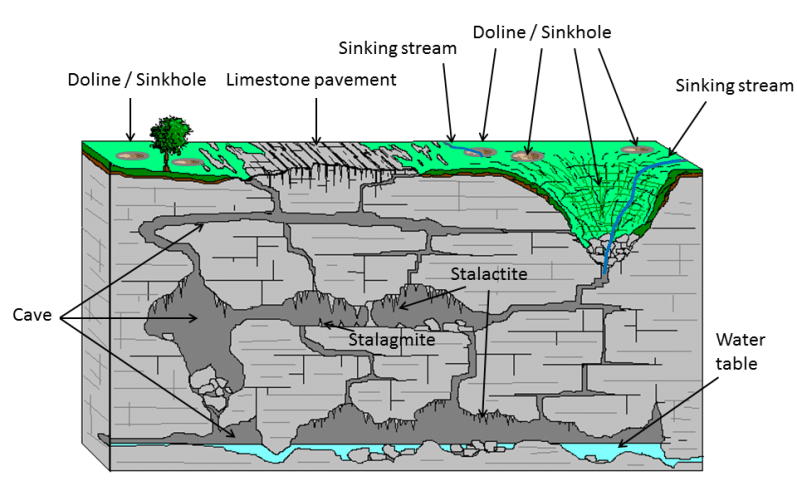
Characteristics of Karst Landforms
- Generally, Karst regions have a bleak landscape, occasionally broken by precipitous slopes.
- General absence of surface drainage as most of the surface water percolate underground, hence surface valleys are generally dry.
- Streams generally cut their way along the joints & fissures of the rock wearing out a system of underground channels.
- When the water penetrates to the base of the limestone & meets the non-porous rocks, it reemerges onto the surfaces as a spring or resurgence.
- Limestones are well jointed & it is through these joints & cracks that rain water finds its way into the underlying rock.
- Progressive widening by the solution enlarges these cracks into trenches & a most intriguing feature called limestone pavement is developed.
- The enlarged joints are called Grikes & the isolated, rectangular blocks are termed as clints.
- On the surface of limestone are numerous swallow holes, which are small depressions carved out by solution where rainwater sinks into limestone at the point of weakness, also known as sink holes. Once water has sunk into limestone, it etches out caverns & passages along joints.
- When a number of swallow holes coalesce, a larger hollow is formed & is called a Doline.
- Several dolines may merge as a result of subsidence (gradual caving) to form an even larger depression called an Uvala
- In Yugoslavia, some very large depressions called Polje, may be as large as 100 square miles, but produced partly due to faulting.
- Subterranean streams which descent through swallow holes to the underground passes leads to the formation of caves & caverns which may contain ponds or lakes.
- The most spectacular underground features that adorn the limestone caves are
- Stalactites
- Stalagmites
- Calcite pillars
- Water carries calcium in solution & when this lime charged water evaporates, it leaves behind solidified crystalline calcium carbonate.
- Stalactites are sharp, slender, downward growing pinnacles that hang from the cave roofs.
- When moisture drips from the roof, it trickles down the stalactites & drops to the floor, where calcium is deposited to form Stalagmites, Which are shorter, fatter & more round.
- Over a longer period, the stalactite hanging from the roof is eventually joined to stalagmite growing from the floor to form a pillar.
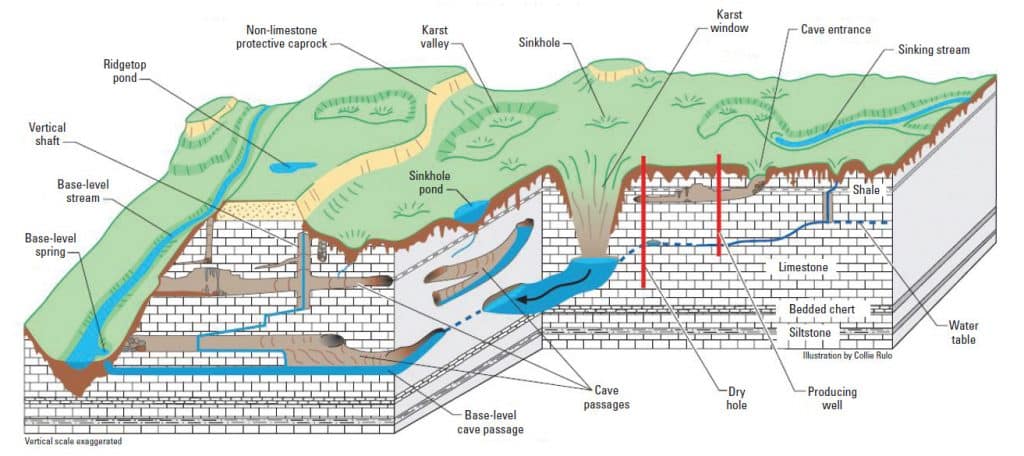
Erosional landforms of Karst topography
Blind Valley
- A steephead valley, steephead or blind valley is a deep, narrow, flat bottomed valley with an abrupt ending.
- Karst valley abruptly terminated by the passage underground of the watercourse which has hitherto resisted the karst processes and remained at the surface.
Swallow Hole/Sinkholes/Doline
- A sinkhole, also known as a cenote, sink, sink-hole, swallet, swallow hole, or doline (the different terms for sinkholes are often used interchangeably), is a depression or hole in the ground caused by some form of collapse of the surface layer.
- Most are caused by karst processes – for example, the chemical dissolutionof carbonate rocks or suffosion processes
- The surface streams which sink disappear underground through swallow holes.
- Local names:
- Black hole – Sea water
- Blue hole- deep under water
- Cenotes- Belize (British Honduras)
- Sotanos- Mexico
- Tomo- New Zealand

Clift
- When the Solution hole is dippen over a period of time then the dipped part is called Clift.
Pinnacles
- Vertical rock blades fretted sharped by dissolution.
Lapies/Karren
- It is formed due to differential solution activity along parallel to sub-parallel joints. They are also called grooved, fluted and ridge-like features in an open limestone field.
- The most widespread surface karst landforms are small solution pits, grooves and runnels, collectively called Karren.
Limestone Pavements
- It is a smoother form of lapies.
Sinking Creeks/Bogas
- In a valley, the water often gets lost through cracks and fissures in the bed. These are called sinking creeks, and if their tops are open, they are called bogas.
Karst Window/Fenster
- Karst fenster is a geomorphic feature formed from the dissolution of carbonate bedrock.
- In this feature, a spring emerges, then the discharge abruptly disappears into a sinkhole.
- A karst fenster is caused by a caving in of portions of the roof of a subterranean stream, thus making some of the underground stream visible from the surface.
- When a number of adjoining sink holes collapse, they form an open, broad area called a karst window.
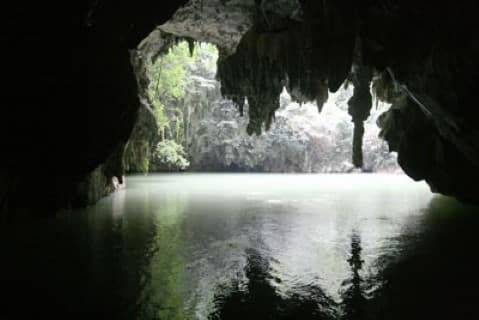
Uvalas
- Karst depressions that are much larger than sinkholes and that display gentler slopes and more complex three-dimensional shapes are known as uvalas.
- Uvalas is collection of multiple smaller individual sinkholes that coalesce into a compound sinkhole.
- A single uvala typically contains numerous sinkholes within it.
Polje
- A polje, also karst polje or karst field, is a large flat plain found in karstic geological regions of the world, with areas usually 5 to 400 km².
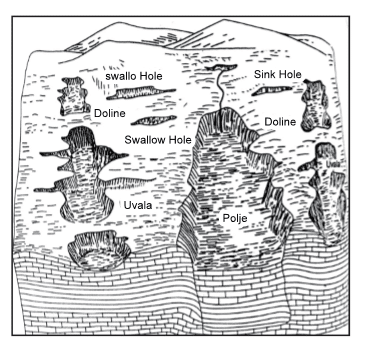
Pools
- An opening at the top with water collected in the void of the surface with varying depth
Caves/Cavern
- This is an underground cave formed by water action by various methods in a limestone or chalk area.
- Cave formation is prominent in areas where there are alternating beds of rocks (shales, sandstones, quartzites) with limestones or dolomites in between or in areas where limestones are dense, massive and occurring as thick beds
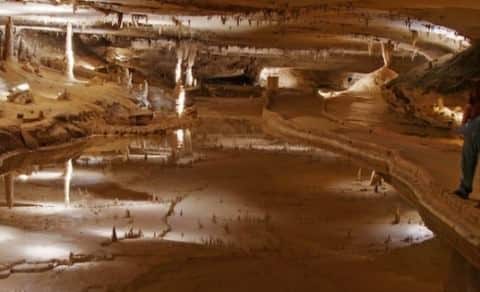
Karst Lake
- Karst lakes are formed as the result of a collapse of subterranean caves, especially in water soluble rocks
such as limestone, gypsum, and dolomite. - This process is known as karstification. They can cover areas of several 100 square kilometers.
- Their shallow lakebed is usually an insoluble layer of sediment so that water is impounded, leading to the formation of lakes. Many karst lakes only exist periodically but return regularly after heavy rainfall

Depositional landforms of Karst topography
Speleothems
- All types of deposits in the caverns are collectively called ‘speleothems’ of which calcite is the common constituent.
- Speleothems most commonly form in calcareous caves due to carbonate dissolution reactions. They can take a variety of forms, depending on their depositional history and environment.
Stalactites & Helictite
- The water containing limestone in solution, seeps through the roof in the form of a continuous chain of drops.
- A portion of the roof hangs on the roof and on evaporation of water, a small deposit of limestone is left behind contributing to the formation of a stalactite, growing downwards from the roof.
- Usually, the base is broader than the free end of the hanging stalactites.
- The ones that descend vertically are known as stalactites, whereas the ones that extend horizontally or diagonally are known as helictites.
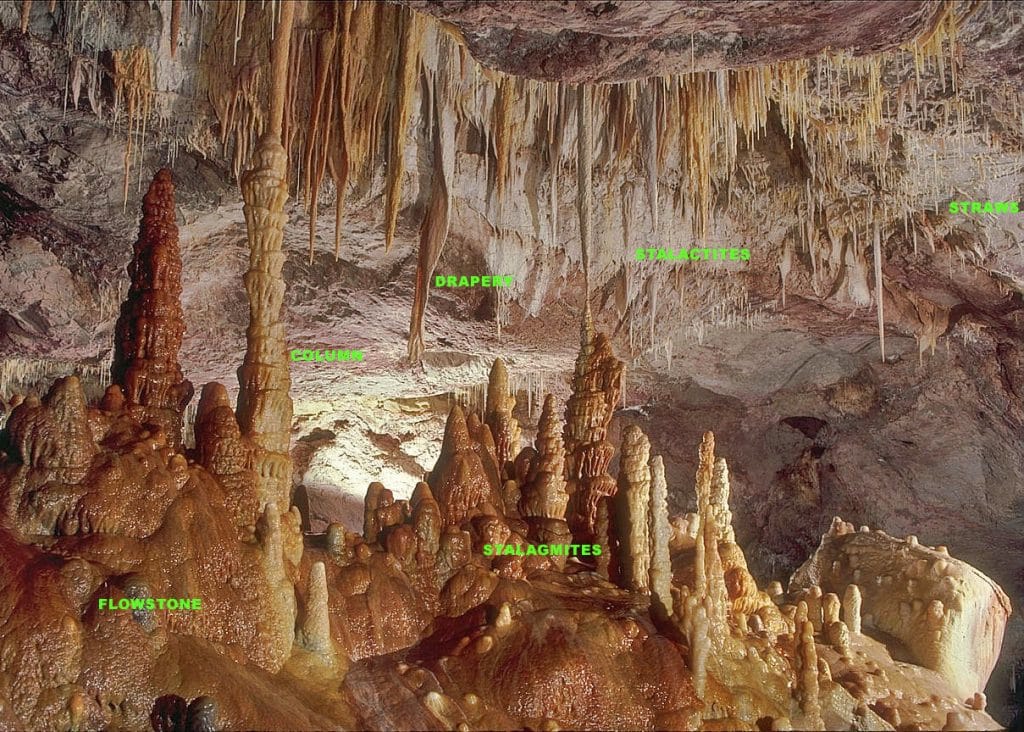
Stalagmites & Halagmite
- A stalagmite is a type of rock formation that rises from the floor of a cave due to the accumulation of material deposited on the floor from the ceiling drippings.
- It is an upward-growing mound of mineral deposits that have precipitated from water dripping onto the floor of a cave.
- Ones that extend horizontally or diagonally from stalagmites are known as Halagmite.
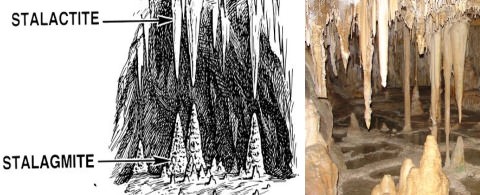
Cave Pillars
- The combination or fusion of stalactites and stalagmites form the pillars
- The diameters of pillars vary
Drapes/Curtain
- Numerous needle-shaped dripstones hanging from the cave ceiling are called Drapes or Curtains.
Tufa
- Tufa is a variety of limestone formed when carbonate minerals precipitate out of ambient temperature water.
- Geothermally heated hot springs sometimes produce similar (but less porous) carbonate deposits, which are known as travertine.
Travertine
- Travertine is a sedimentary rock formed by the chemical precipitation of calcium carbonate minerals from freshwater, typically in springs, rivers, and lakes that is, from surface and ground waters.
- Developed form of Tufa is Travertine.
Drip Stone
- Calcium carbonate rock deposited in caves by the precipitation of calcite from water as excess dissolved carbon dioxide is diffused into the atmosphere.
- Dripstone takes various forms, including stalactites, helictites (having spiral form), curtains, ribbons, and stalagmites.
Terra Rossa
- Terra Rossa is a well-drained, reddish, clayey to silty clayey soil with neutral pH conditions.
Human activities of Karst region
- Karst regions are often barren & at best carry a thin layer of soil.
- The porosity of the rocks & the absence of surface drainage make vegetative growth difficult, hence limestone can usually support only poor grass.
- Limestone vegetation in tropical regions is luxuriant because of heavy rainfall all the year around.
- The only mineral found in association of limestones is lead.
- Good quality limestone is used as building materials & quarried for cement industry.
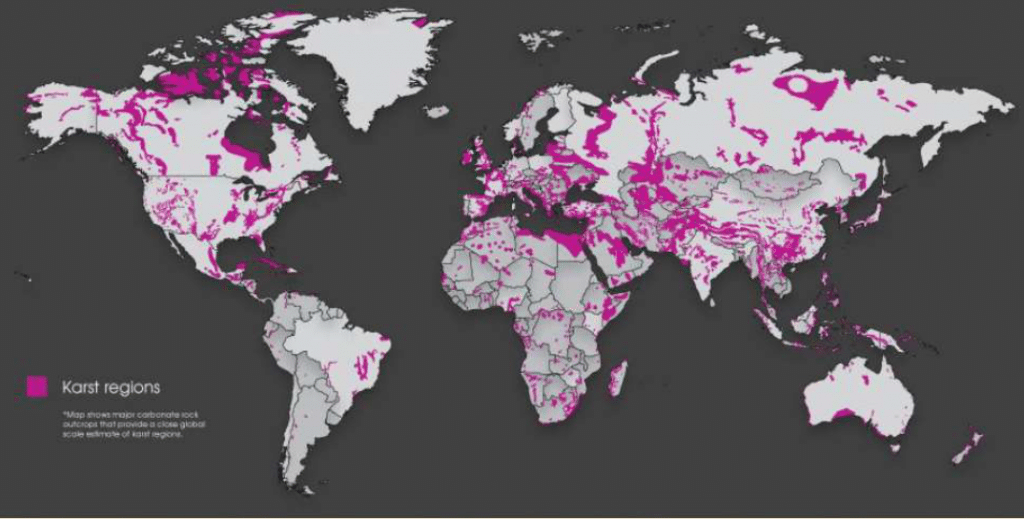

Thanks for valuable notes sir
Very nice content
Though Lotusarise has put amazing efforts to create the above content but UPSC 2022 has asked about “Speleothems” which is part of karst landforms (depositional landforms). Titled in the Savindra Singh: Geomorphology (Page no 443). The conclusion is, though you read all notes, PYQs… UPSC will definitely ask one or two question what exactly you missed out 😂. By the way kudos to the efforts of Lotus Arise👍🏻👍🏻
it(Speleothems) is also mentioned in these notes.. read carefully.
Thanks for providing such organized material for geography Optional.
Ncert me kuch sthaniy karst pradesh ke name puchha hai
Kya aap ise similar kr skte hai?